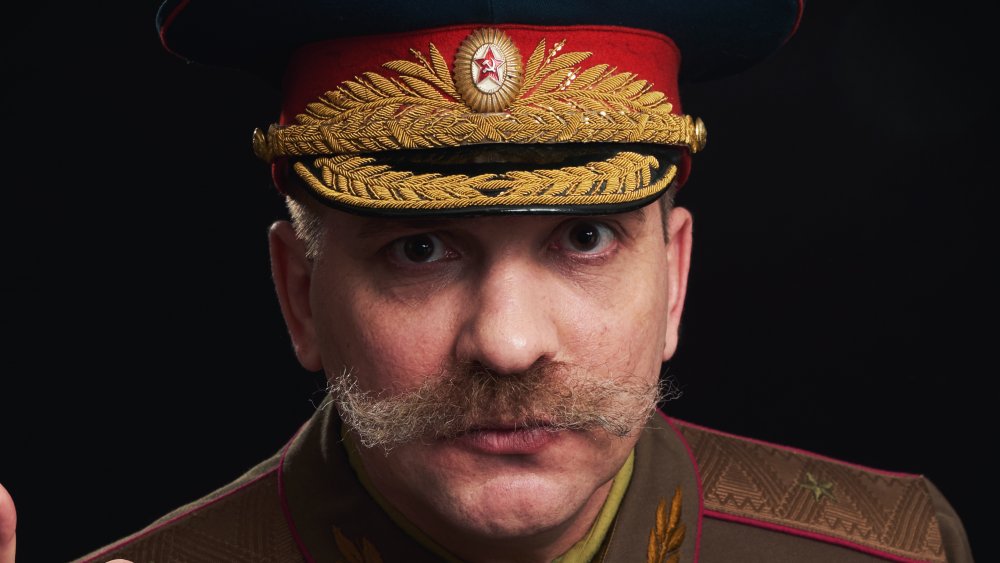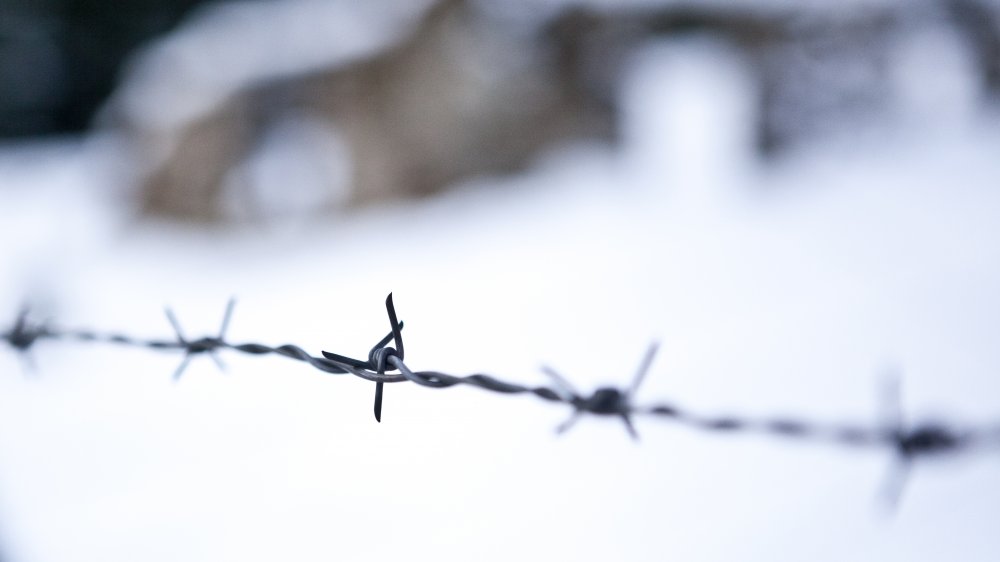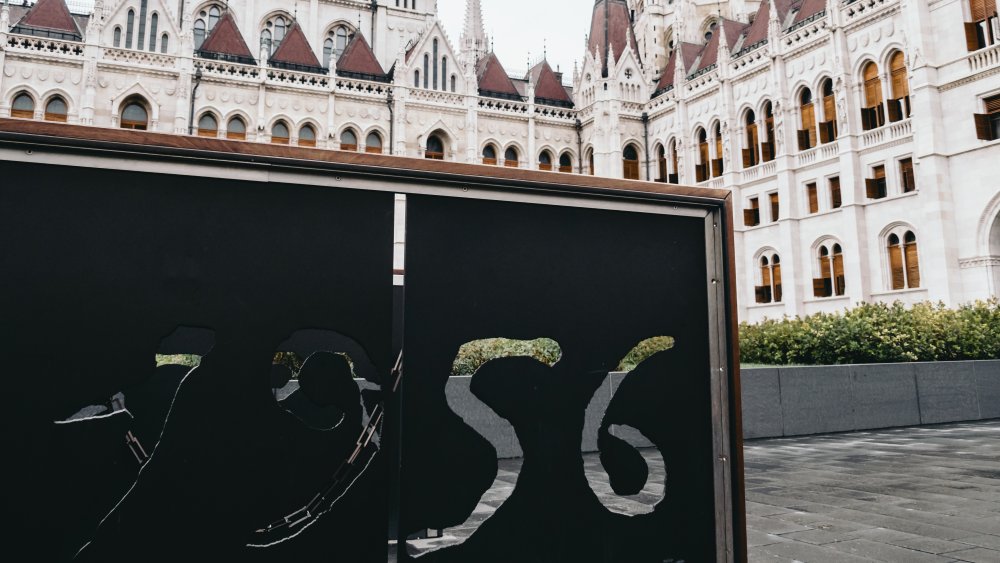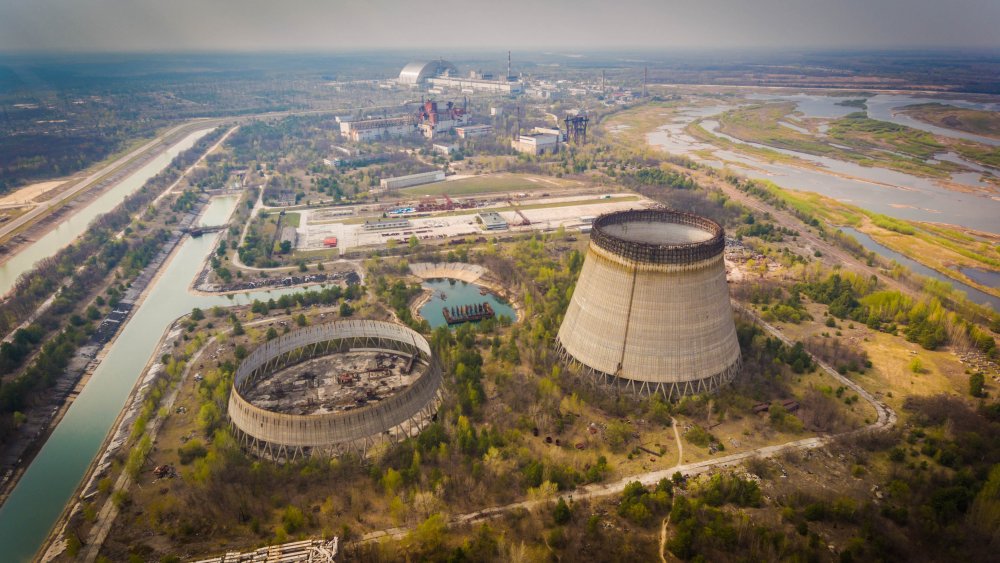The Worst Part Of The USSR Isn't What You Think
Everyone who grew up in the United States during the 1980s knew two things: The Americans were the good guys, and the Soviets were the bad guys. It was a different story if you were in Russia, but you know, over here we knew that those missiles were trained on us, we were supposed to jump under our desks when the nuclear strike happened (like that would accomplish absolutely anything), and also communism was evil. As far as we were concerned, the whole "threatening the United States with total annihilation" was like the worst thing that the USSR ever did.
Well, granted, that was pretty bad. But threatening millions of people with total annihilation is nothing compared to actually annihilating people, or imprisoning or institutionalizing people for stupid reasons, or torturing people, or trying to cross breed people with chimpanzees — there are a lot of much, much worse things a nation can do and the Soviet Union did most of them. So here it is, all the stuff that's way, way worse than the worst thing you thought you knew about the USSR.
The USSR imprisoned scientists for doing anti-communist science
Okay, so what is "anti-communist science," exactly? Well, it's any science that doesn't support the fundamental biology of communism. Yes, communism is built into all of the world's processes, including the rising and setting of the sun, the rise and fall of the tides, and actual carbon-based life.
Genetics says plants and animals are born with characteristics encoded into their genes, and those characteristics can't be shaped or altered by their environment. But Marxism says plants and animals are shaped only by the environment, and can therefore be "educated" into doing things that they otherwise wouldn't do. According to the Atlantic, a Soviet scientist named Lysenko thought if he "taught" seeds to grow in cold temperatures, they would pass those lessons down to their progeny, thus making it possible to grow oranges in Siberia. He was wrong, but no one could say so because if they did, they'd find themselves disappeared.
The Soviets loved Lysenko because he made them believe it was possible to turn barren land (and the USSR had a lot of barren land) into prosperous farms, so they put him in charge of the nation's agriculture. Meanwhile dissenters got fired and shipped off to prisons where they starved to death. Some of them were named enemies of the state and executed. The government still tries to interfere with science these days, even in America, but at least there's less death.
The KGB used castration as a negotiating device
In September 1985, a Lebanese outfit called the Islamic Liberation Organization kidnapped four Russian diplomats and threatened to kill them one by one unless Russia used their political clout to persuade pro-Syrian militiamen to stop attacking Muslims in the Lebanese city of Tripoli. To prove they were serious, one of the diplomats was murdered just days after the abduction.
Now, when this sort of thing happens to Americans, it extra-sucks because America has a pretty strong policy against negotiating with terrorists, because negotiating with terrorists is sort of like buying candy for your whining kid to make her shut the hell up. As soon as she figures out how effective the whining is, she'll never stop whining.
The USSR, though, had no such policy. According to UPI, they solved the problem with good old fashioned negotiation, you know, the kind where you mutilate your enemy and send pieces of him back to his family in a box. Yes, the KGB found themselves a relative of a Lebanese fundamentalist leader, shot him in the head, cut off his testicles (not necessarily in that order), and sent the severed body parts to his family member with a warning that additional relatives would meet a similar fate if the rest of the Soviet diplomats were not immediately released. And that was pretty much all it took — the diplomats were released and everyone (except the two guys who died horribly) lived happily ever after.
The USSR massacred a bunch of Polish military officers
Sixteen days after Germany invaded Poland from the west, the Soviet Union invaded from the east. The two invading forces did things pretty differently — Germany was all about massacring Polish Jews, while the USSR stuck with Polish military officers, policemen, and the like. Both countries put their prisoners in camps, and both committed atrocities, though it's only the German atrocities you tend to hear about.
According to the National Archives, the Germans found out what the Soviets had been up to in 1943, when they discovered eight mass graves in the Katyn Forest, which is near Smolensk in Russia. The graves contained thousands of bodies — most belonged to Polish Army officers and intellectuals. A German inquiry concluded that the Soviets carried out the massacre; a Soviet inquiry concluded that it was the Germans. Meanwhile, the Americans were all, "Um, we have no idea but let's all just try to get along so we can win this war okay?"
It wasn't until after the war that anyone went seriously in search of the truth. In 1951, a committee appointed by the U.S. House of Representatives concluded unanimously that the massacre was the work of the Soviet People's Commissariat for Internal Affairs, who were the folks running the prison camps at the time of the massacre. They also concluded that America had been kind of slow to figure out that maybe the Soviets weren't good guys. Hmm, ya think?
The USSR institutionalized people as mentally ill if they didn't believe in communism
Modern medicine has come a long way since the days when people were institutionalized for things like disagreeing with their husbands and being poor. And hey, maybe we are still inventing mental illnesses we can slap on people who don't agree with the government, but so far no one has been institutionalized for any of them. So far.
The Soviet Union went one step beyond just creating a label for people who disagreed with communism — it was a bona fide diagnosis. According to Timeline, the Soviets called this handy mental illness "sluggish schizophrenia," and anyone who dissented from hard-line communist thought was most definitely a sufferer. That meant that simply speaking out against the Soviet government, distributing a leaflet, or defending the rights of people who were subject to oppression by the state was symptomatic of mental illness. "Sufferers" could be institutionalized, given high doses of antipsychotic drugs, put into insulin-induced comas, or whatever "treatment" doctors saw fit.
"A crime is a deviation from the generally recognized standards of behavior," Soviet leader Nikita Khrushchev said in a speech. "To those who might start calling for opposition to communism on this basis, we can say that ... clearly the mental state of such people is not normal." Right, which meant that the United States was a whole nation of people without normal mental state, but hey, we're still not actually 100 percent sure that's not accurate.
The USSR sent prisoners to "Cannibal Island"
Okay, so, you don't need to know anything beyond the fact that one of their prison camps was called "Cannibal Island" in order to figure out that the Soviets were crappy people doing very crappy things. But let's just elaborate so you can properly distinguish between bird poop on the windshield crappy and the kind of crappy where a T-Rex comes along and eats your whole car and then your car literally becomes a pile of crap crappy.
According to the Times, the people who got shipped off to Cannibal Island were mostly prisoners who were rounded up by Joseph Stalin in the early 1930s. The Soviets didn't call it "Cannibal Island," of course, because that would have been way too obvious. They called the island Nazino, which ironically is long for "Nazi," though it didn't have anything to do with actual Nazis since this was before the official start of World War II.
Nazino had no trees, no bushes, and no facilities. Prisoners were dumped there in the open, and left without food or shelter for days. Around 6,000 people ended up on Nazino in the late spring of 1933, and within four weeks about 4,000 of them were dead. As the people around them died, survivors resorted to cannibalism and sometimes even murder and then cannibalism. And remember, these people were citizens of the Soviet Union. It's safe to say at this point there weren't many people around the world longing to vacation in Russia.
The USSR sent their own people to brutal forced labor camps
The Soviets weren't dumb enough to just send everyone to a barren island without food or shelter, though. No, because there were a lot of untapped resources in the Soviet Union, and what better way to get at untapped resources than to build labor camps and make prisoners do all the work for free?
More than 18 million people were incarcerated in the Soviet Gulag system. According to History, Gulag at its most horrible was a system of hundreds of labor camps housing up to 10,000 people each. Prisoners had to work up to 14 hours a day regardless of the weather, and deaths by starvation, random epidemic diseases, and exhaustion were pretty common. Stalin loved the Gulag because prisoners were able to mine valuable resources or build canals and highways for little more than the price of some crappy food. And because they were prisoners, the Soviets didn't have to bother with lame concerns like safety equipment or tools that were actually efficient. Prisoners cut down trees with handsaws and mined with their bare hands.
You could end up in Gulag for a myriad of reasons, like revolting against communist ideals or being an artist or a scientist. Gulag was an equal opportunity incarcerator, imprisoning men, women, and even children. And it wasn't always enough to just keep your head down and praise the USSR, either — just about anyone could get sent to Gulag and no one had to give you a reason. What was all that about the evils of the monarchy again?
The USSR brutally put down the Hungarian revolution
In the west, we protest whenever we're unhappy about anything. Wages too low? Take to the streets. Potholes too deep? Sell $20 calendars featuring naked people posing inside of them. In the west, protesting is a freaking art form. But in other nations, protesting is dangerous, even deadly, and no greater example of this fact exists anywhere else but in the Soviet Union.
According to History, in 1956 unhappy people in Hungary filled the streets, demanding political freedom and democracy from their Soviet overlords. In response, the Soviets appointed a premier to help restore order, but their premier decided to side with the Hungarians instead of the Soviets. So 12 days after the uprising began, Soviet tanks showed up in the capital city of Budapest and killed 2,500 people, forcing another 200,000 to flee.
Meanwhile, America was all, "Sorry about your plight, Hungarians," but basically did nothing. The end.
The USSR botched the whole Chernobyl thing
Today, everyone knows about Chernobyl. The name is synonymous with nuclear disaster and hard-to-watch HBO miniseries that aren't entirely accurate.
When it happened, though, the Soviets were desperate to keep the situation under wraps. No one outside of the USSR could know that the great and powerful nation had experienced such a massive failure of technology and policy. So, they downplayed the significance of the disaster. They waited a day and a half before evacuating the people who lived in nearby Pripyat. They sent human "liquidators" into the danger zone in a desperate bid to clean up their mess. These people were tasked with removing debris, decontaminating the area, and building a "sarcophagus" to contain the radiation. They weren't always told how dangerous their jobs were — in part because the Soviets didn't want them to know, and in part because the Soviets didn't really know themselves.
According to National Geographic, at least 28 people died in the early days of the disaster, and 6,000 kids went on to develop thyroid cancer. In total, about 600,000 liquidators were sent into the danger zone — around half of them received doses of radiation roughly 1,200 times what you would get during an X-ray. The WHO estimates that the incidence of leukemia amongst Chernobyl's liquidators is roughly double the regular population, and that up to 4,000 additional liquidators will ultimately succumb to some other type of cancer.
The USSR engineered a famine in Ukraine
In 1928, the Soviets implemented a program called "agricultural collectivization," which forced farmers to give up their lands, livestock, and all their equipment so they could join a state-owned agriculture collective. Sounds like a great idea.
Farmers in Ukraine weren't into the idea, though, because it smacked of medieval serfdom. Many of them refused to join, which is totally not an awesome idea if you're living under Soviet rule, but kudos. It didn't last, of course. According to Holodomorct.org, the state forcibly confiscated their lands and property and shipped them off to Siberia, where they were dumped in remote places with no food or shelter. Meanwhile, the Soviets increased production quotas to unrealistic levels, while simultaneously prohibiting farmers from eating any of the food that they were growing.
It gets worse, though. Starvation actually became policy — the Soviets established military blockades around villages in Ukraine to ensure that no food would enter, and that hungry people could not leave. The Soviets regularly searched villages for hidden food stores. By 1933, 30,000 people were dying in Ukraine every single day. And while all of this was happening, the Soviets were exporting millions of tons of grain out of the country and telling the world that everything was cool in Ukraine. The total death toll during the Soviet's engineered famine was roughly 4 million people.
The USSR tried to make an human-ape hybrid
When you're so evil that you starve your own people on purpose, well, pretty much nothing is off-limits. In 1926, a biologist named Ilia Ivanov decided to build on his success creating totally useless hybrid animals to see if he could create a hybrid out of a human and an ape.
For some reason, the Bolsheviks were into this idea. According to NewScientist, it might have had more to do with sticking it to religion than creating a race of half human, half chimp slaves — if the Soviets could create a human-ape hybrid, then they could prove that Darwin was right and religion was wrong. Or, it could have been because the Soviets wanted to prove that it was possible to mold human beings into a compliant, Soviet ideal, which might one day mean breeding people who didn't care about owning stuff or getting ahead in life.
Ivanov traveled to Guinea and caught some chimps, then artificially inseminated three of them with human sperm (it didn't work). Then he decided to inseminate local women with chimp sperm — no one would volunteer for such a thing, though, so he was going to do it secretly during a "medical examination." Shockingly, the governor of Guinea told him "no." He tried to bring chimps back to the Soviet Union to continue his work, but they did not thrive and eventually he ended up exiled to Kazakhstan as a part of the Soviet purge of scientists.
The USSR's mass human rights violations after the Battle of Berlin
The USSR helped defeat Nazi Germany. That's an established fact. But just because they had a hand in taking down an evil regime does not mean that they were not themselves an evil regime.
According to the BBC, the USSR did some pretty medieval things in the waning months of the war, including the sack of Berlin, or more accurately, the rape of Berlin. As Soviet troops pushed through the city during April and May of 1945, they physically assaulted German women who were trying to protect themselves and their city. The Red Army justified the attacks by pointing out that German soldiers had been assaulting Russian women for four years, therefore a little revenge was perfectly acceptable.
It was more than just a little revenge, though. Documents reveal that the rate of mass assault on German women was so profound that some German women would attempt suicide or worse, attempt to kill their own children to avoid the onslaught of Russian violence. Some would devote themselves to a single Russian soldier or officer to avoid becoming the victim of others. Either way, it was horrible, it continued for weeks, and the Soviet's attitude about it was basically, "Welp, that's the cost of doing war."
The USSR's ethnic cleansing
It will probably not surprise you to hear that Nazi Germany wasn't the only 20th century nation that believed in the supremacy of one race over another. It wasn't even one of two, to be honest, but like Nazi Germany, the Soviets blatantly and shamelessly acted on those ideas. According to Ethnic Cleansing in the USSR, 1937-1949, "The Stalin regime deported these national groups in their entirety based solely upon their ethnicity to areas whose living conditions inevitably lead to hundreds of thousands of deaths." Between 1941 and 1948, more than 3 million people ended up in these "special settlements," where roughly one in 10 of them died.
Stalin was especially suspicious of immigrants. He believed they were spies, plotting against the Soviet government with their ethnic leaders in their homelands. Sending them off to remote parts of Russia was a pretty tidy way to deal with the "problem." He wasn't killing them, precisely, he was just getting them out of the way. What happened to them afterwards was clearly not his problem. And that's pretty much the foundation of the entire history of the Soviet Union.












